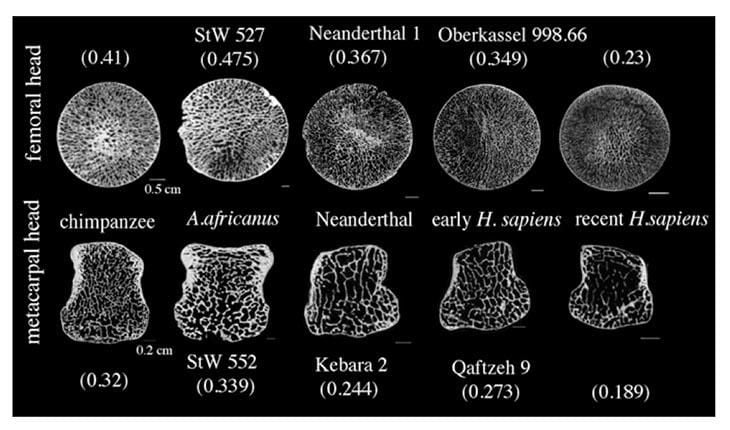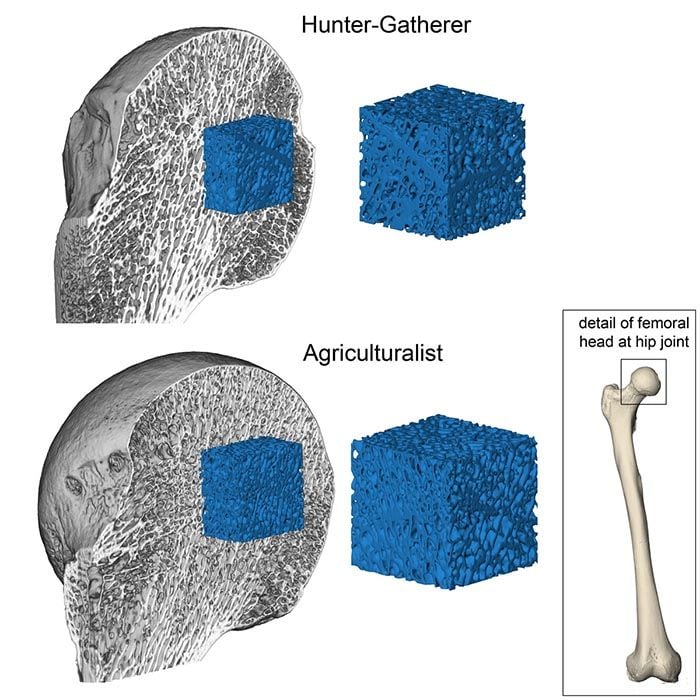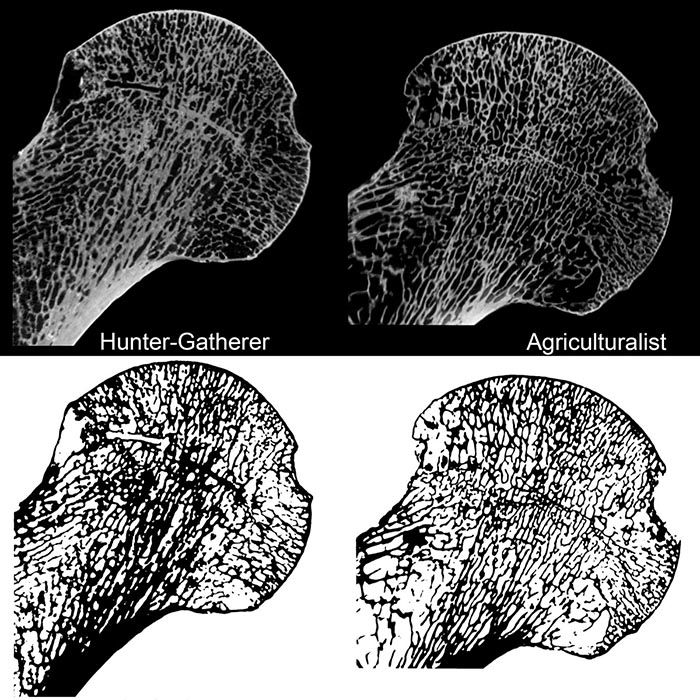Switching to Farming Made Human Joint Bones Lighter
A more fragile skeleton evolved about 12,000 years ago, probably driven by a shift from hunting to agriculture
/https://tf-cmsv2-smithsonianmag-media.s3.amazonaws.com/filer/78/78/78785d51-5592-4036-9d93-c14ebd4d753e/bj002021edit.jpg)
Spending more time sitting on our butts isn't just a problem for obesity and heart disease. The shift to a more sedentary lifestyle has probably been bad for our bones, too. A pair of papers published today in the Proceedings of the National Academy of Sciences suggest that humans evolved lighter joint bones relatively recently in our evolutionary history as a response to changes in physical activity.
One study pinpoints the origin of these weaker bones at the beginning of the Holocene epoch roughly 12,000 years ago, when humans began adopting agriculture. “Modern human skeletons have shifted quite recently towards lighter—more fragile, if you like—bodies. It started when we adopted agriculture. Our diets changed. Our levels of activity changed,” says study co-author Habiba Chirchir, an anthropologist in the Smithsonian’s Human Origins Program.
The second study attributes joint bone weakness to different levels of physical activity in ancient human societies, also related to hunting versus farming. Both works have implications for modern human health and the importance of physical activity to bone strength.
“The lightly-built skeleton of modern humans has a direct and important impact on bone strength and stiffness,” says Tim Ryan, an anthropologist at Penn State University and a co-author on the second study. That's because lightness can translate to weakness—more broken bones and a higher incidence of osteoporosis and age-related bone loss.
Scientists already knew that the modern human skeleton is longer, thinner and generally weaker than that of its hominin predecessors, but no one was sure what has been driving this “gracility.” Previous studies suggested that walking upright put more pressure on joints to go long and lean, while others argued that a decrease in physical activity or changes in diet has been behind these skeletal changes.
Recently, scientists have zeroed in on trabecular bone, the sponge-like material that’s found at the ends of the bones that form joints. “Think of the end of a chicken bone: If you cut through it, then you see this meshwork of bone that’s interwoven,” says Chirchir. Modern humans have lower trabecular bone density within specific bones than their ancestors.
Spongy bone responds to mechanical stress, so Chirchir and her colleagues decided to take CT scans of the hand bones of primates, including humans, to see if the bone differed based on how the animals moved. “We though that if an orangutan climbs, it should have a different structure of trabecular bone than knuckle-walkers like chimpanzees,” says Chirchir.
The team noticed that scans of human hands looked drastically different than those of their primate relatives. In the CT scans, air bubbles appear dark against a white backdrop of bone. “The human hand had very little white compared to the other primate hand bones,” says Chirchir, indicating that it might be incredibly airy and light. “So that was the striking thing.” She and her colleagues wondered how the density of trabecular bone in the rest of the human skeleton compared to that in other primates and early human ancestors.

The team scanned circular cross-sections of seven bones in the upper and lower limb joints in chimpanzees, Bornean orangutans and baboons. They also scanned the same bones in modern and early modern humans as well as Neanderthals, Paranthropus robustus, Australopithecus africanus and other Australopithecines. They then measured the amount of white bone in the scans against the total area to find trabecular bone density. Crunching the numbers confirmed their visual suspicions. Modern humans had 50 to 75 percent less dense trabecular bone than chimpanzees, and some hominins had bones that were twice as dense compared to those in modern humans.
So when did trabecular bone density start to drop in the human family tree? The team found that early Homo sapiens had pretty dense spongy bone until either the late Pleistocene or the early Holocene—when humans were undergoing some major lifestyle transitions, such as growing food and raising livestock rather than going out to hunt. That probably means the selection pressure for heavier bones started to decrease.
“What we think is going on is that humans were becoming less active, more sedentary. People were adopting farming, domesticating animals. That reduction in physical activity is what’s resulted in this light skeleton,” says Chirchir. But this study only looked at one factor in trabecular bone—density. The spongy bone's thickness, volume and surface area can tell us a lot about how strong joint bones are. The work also didn’t look at modern human foragers to see if their increased activity gave them stronger joints. That’s where the second study comes in.
Ryan teamed up with Colin Shaw at the University of Cambridge to examine trabecular bone in archaeological specimens from four ancient human groups—two that practiced agriculture and two that foraged—in what is now Illinois. The researchers focused on the hip joint because it’s important for bearing the weight of the human skeleton during walking.
Foragers, they found, had thicker trabecular bone, higher volume and lower surface area in their hips than the farmers. The two farming groups didn’t differ from each other, and “both sedentary groups also consumed a range of locally available foods, meaning that their diets were not necessarily deficient,” says Ryan. This suggests that diet is less important than the biomechanical stress walking long distances and hunting animals puts on human hips.
While Chirchir points out that they can't rule out factors like diet or disease, both studies point to physical activity as the driving factor behind these changes to our skeletons. She also notes that physical activity can change our skeletons over the course of evolutionary history and within our own lifetimes. That’s important for those of us living in industrialized environments, where we spend a lot of time sitting at work and at home. Cases of osteoporosis are more common in such locales, and in patients with osteoporosis, trabecular bone has the highest risk of facture.
“Humans can have robust trabecular bone structure, similar to what is seen in living non-human primates, if they engage in appropriate levels of physical activity throughout life,” says Ryan. That could cut hip fractures related to bone loss with age. So perhaps instead of eating like early humans, we should be exercising like them.
/https://tf-cmsv2-smithsonianmag-media.s3.amazonaws.com/accounts/headshot/Screen_Shot_2014-01-27_at_12.05.16_PM.png)


/https://tf-cmsv2-smithsonianmag-media.s3.amazonaws.com/accounts/headshot/Screen_Shot_2014-01-27_at_12.05.16_PM.png)